Winter has many joys, but its sorrows are also well-known. Darkness falls so early, days are often cold and gray, summer's outdoor activities seem only a distant memory.
But if winter's cold, dark days lend themselves to anything, it is cooking and baking. Whether for a holiday or just a weekday dinner, it's comforting to spend time in a cozy kitchen, warmed by the oven, producing soups, cookies, breads and more.
There's a good sampling of new cookbooks out this holiday season, many centering on baking. Here's our roundup of some of the offerings.
Cookie monster
Home bakers cross some kind of line when we make our first order from Vermont's . Suddenly, supermarket staples are no longer good enough for us, and we're ordering special yeast, bread-base mix-ins, and more. Last year King Arthur came out with its Baking Companion cookbook, and now just in time for the holidays, there's "The King Arthur Flour Cookie Companion" (Countryman Press, $30).
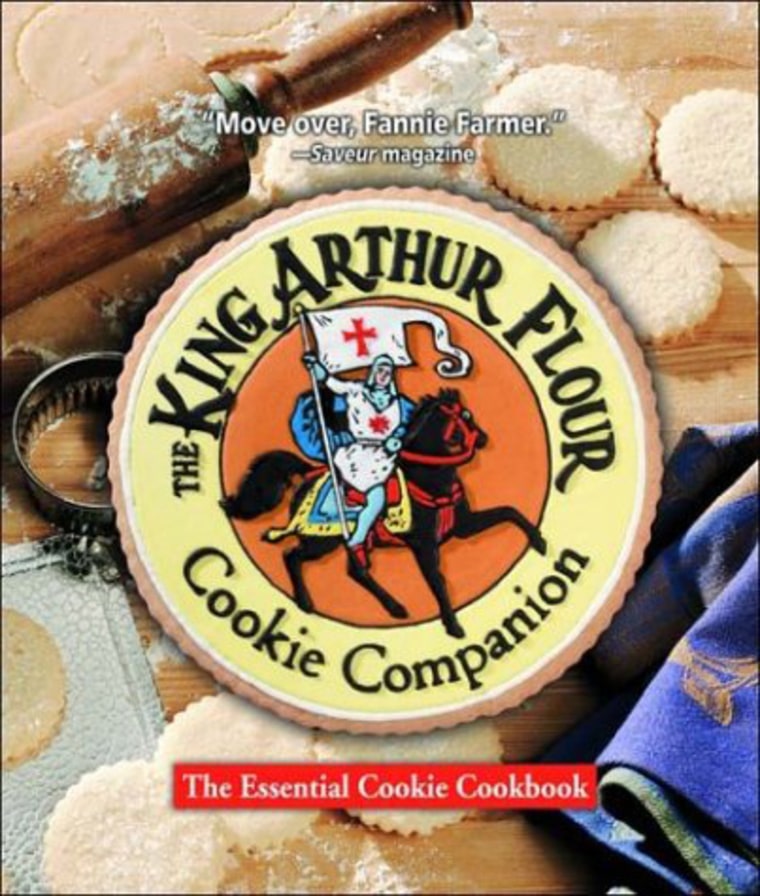
The Companions are not small books, and if you've already got the Baking Companion, you might want to think twice about the Cookie Companion. But if you live for an annual cookie exchange, this is your book.
Some of the recipes, such as the delicate Vanilla Dreams, require special ingredients (baker's ammonnia for the Dreams), which are available from King Arthur, naturally. But most don't.
I've made plenty of molasses cookies, but King Arthur's recipe was easy and fast, and produced a light, sweet if not exactly spicy treat. Bakers can choose between a soft and crisp recipe, a nice nod to different tastes.
Homemade graham crackers are not something I've ever contemplated baking before seeing the recipe here. They were fun and easy to make, but lacked the smooth, sweet taste of the grocery-store brands. I won't make them again.
I have more luck with a variety of Christmas cookies. One simple recipe allows the baker to make chocolate, vanilla and fruit-flavored doughs (that last uses dry Jello to flavor and color). Once the basic doughs are ready, they can be shaped into any number of swirls, stripes and checkerboards, and my officemates were quite impressed. Another beautiful-looking treat, the stained-glass cookies shown at the top of this story, were exquisite enough to be ornaments. Unfortunately, people tended to eat the cookie part and throw away the hard-candy center, which tasted fine, but wasn't what they expected in a cookie.
Camelot may have existed for only one brief shining moment, but in the world of baking, King Arthur still reigns supreme. —Gael Fashingbauer Cooper
Alton bakes
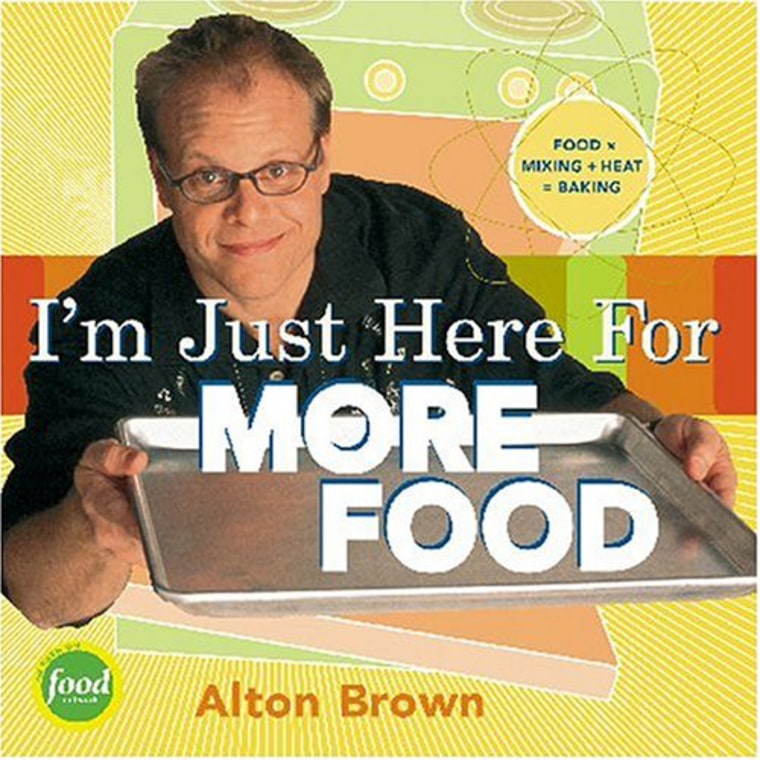
I admit it: I'm an Alton Brown fangirl. With Martha Stewart locked up and , his "Good Eats" is the most entertaining cooking show on television, bar none.
Part of the success of the show is Brown's own goofy, nerdy persona. He appeals to men and women alike, and to experienced as well as novice cooks. He follows up his 2002 James Beard Award-winning "I'm Just Here For the Food," with a baking book, called, aptly enough, "I'm Just Here for More Food" (Stewart, Tabori and Chang, $32.50).
Brown's book takes a little getting used to. It's divided into sections ("The Muffin Method," "The Pie Variation") that explain a certain technique, then go on to offer recipes that utilize it. Since the recipes don't re-explain the method in question, the book has a trick of sorts. Each section begins with a flap that folds out from the book and describes the method's basic steps. When you find the recipe you want to make, you fold the flap explaining the method over the page so you can read the recipe and also consult the steps for the method. It felt a little odd to work this way at first, but I grew to appreciate the practicality.
Brown's book is full of the goofy food science he dramatizes so well on "Good Eats" (fatty acids are illustrated by a drawing of a Disneyland tram), and some of what I learned from this book will stick with me. A baker for years, I never realized that cracking eggs on the sides of bowls could drive shell fragments or germs deep into the egg — I crack mine on flat surfaces now. Thanks, Alton!
Some of the recipes will seem simple to experienced bakers (buttermilk pancakes, banana bread). Most are baked goods, but I did try one main course — Brown's homey chicken and dumplings — and was delighted with the light dumplings and creamy, savory soup (though I may not forgive him for requiring me to buy lard). I wanted to try his recipe for homemade saltines, but while the recipe simply lists "unsalted butter" as an ingredient, a note on the page called for plus gras or clarified butter, and this home cook just couldn't bother to get either. But I was pleased with his pillow bread, a simple yeast bread that rose high and was tasty. Wanting to try a basic baked good, I tried Brown's peanut-butter cookie recipe. A simple recipe for a simple treat, but my husband proclaimed them the best peanut-butter cookies he'd ever had.
While longtime bakers won't get any rare or difficult recipes from Brown, most of us will enjoy his everyman attitude and relaxed take on baking. And while I didn't yet try Brown's recipe for homemade Pop-Tarts, you can bet I will. —G.F.C.
Taste of Italy
Amid the rush of books for the time-squeezed cook, "Italian Slow and Savory" (Chronicle Books, $40) stands out as a love letter to the things that make slow food great. Author Joyce Goldstein, who masterfully channeled Italian wine-bar cuisine in "Enoteca," has compiled a series of Italian dishes that can't be hurried, but pay off in clear, focused flavors.
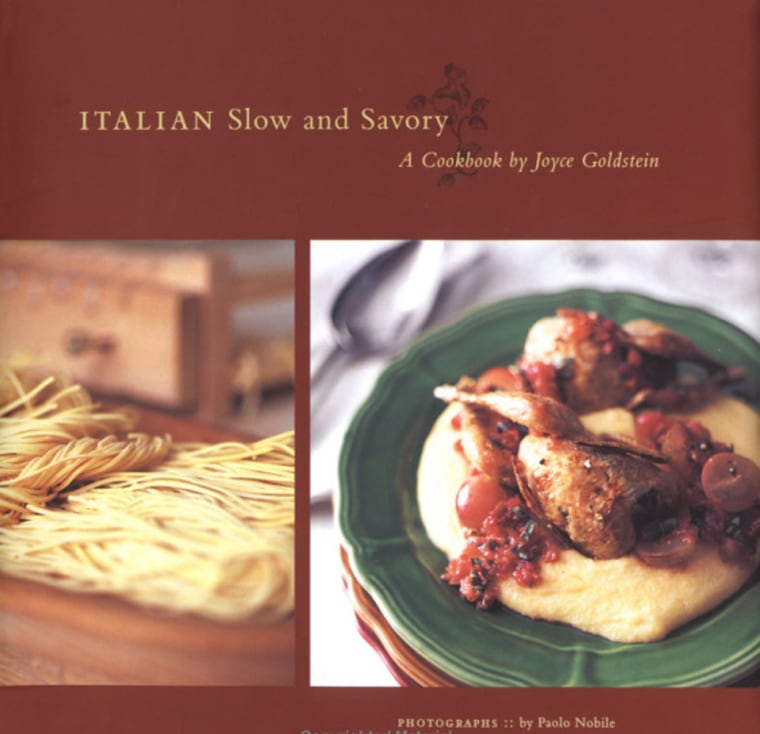
These are weekend recipes, to be sure, with lots of baking and braising: oxtail ragout will take over three hours. But for the intrepid, they offer a world of rustic Italian flavors from the country’s less obvious corners, places like Sardinia and the Veneto. The book benefits from Goldstein’s ability to dig for the unusual, like braised tuna with tomato, garlic and mint from the island of Favignana, off the Sicilian coast.
Determination is rewarded with surprisingly pleasing results. Riso in cavroman, a hearty sort of risotto with tomatoes and lamb (a substitute, we’re told, for cured mutton) is one of the best rice dishes I can remember in a long time. There may be the occasional misfire — some polenta cakes with greens lacked flavor — and given the cooking methods, start-to-finish time estimates would be helpful. But the book brims with the sort of dishes that prompt fond, drooling memories.
Goldstein is also a master at collecting detail, and includes plenty of asides and a helpful précis of Italian regional cuisine. —Jon Bonné
Cooking with attitudeAnthony Bourdain does not shy from attention: First "Kitchen Confidential," then his Food TV road trips. But skeptics kept waiting to see him strut his stuff in the kitchen. Wait no more: His "Les Halles Cookbook" (Bloomsbury, $35) has arrived.
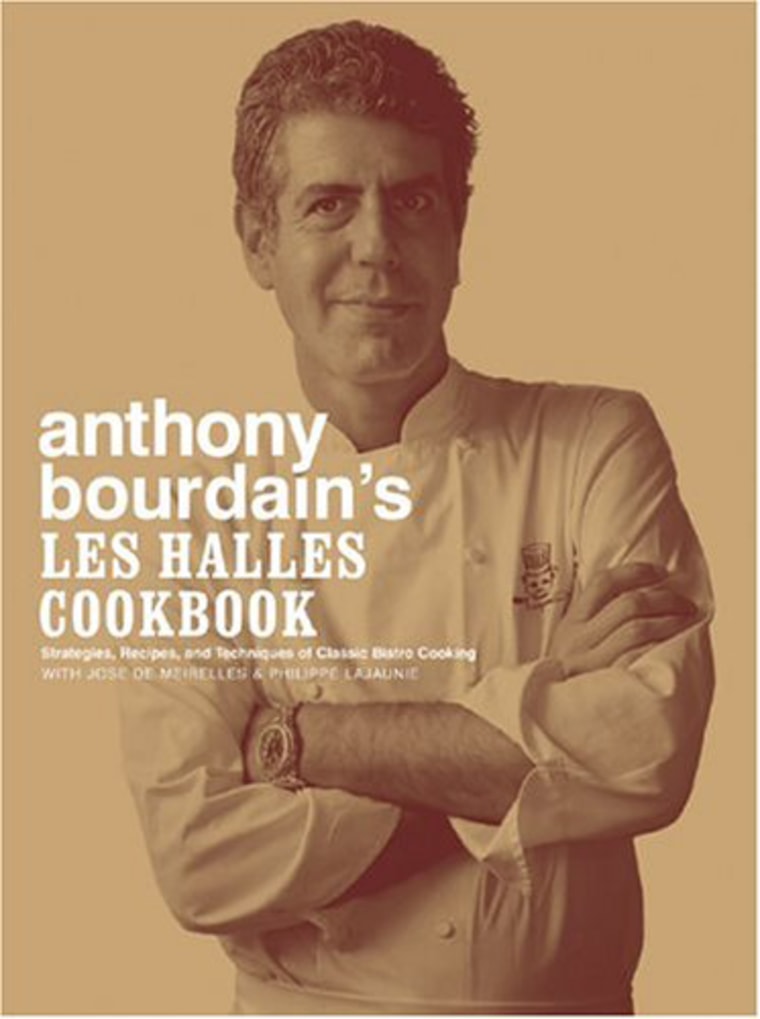
In it, Bourdain says "everything started" with Julia Child. Her devotees may not warm to this effort, the first cookbook I know that calls readers names not printable here.
But Bourdain’s desire is to channel the profane BOH (that’s "back of house," folks) culture of the professional kitchen. He wants readers to understand the nuances of such cooking, to appreciate the value of a good veal stock and a sharp knife. To pass along the beloved principles of the Manhattan bistro that gives the book its name; key among them, that a true chef must embrace meaty bits once found edible through necessity (specifically through French poverty) but now largely out of favor in commoditized America: veal kidneys, blood sausage.
Luckily, his recipes — mostly bistro classics — deliver both helpful lessons and usually error-proof food. Moules a la Grecque is a miracle of simplicity, juicy mussels flavored with fennel and coriander. His steak au poivre recipe deftly balances crushed peppercorns and cognac, and includes some crucial advice on searing meat.
One fewer smartass comment in the margins, traded for an extra detail (like a temperature setting for the mussels) would have served him well. But the layout is thoughtful and utilitarian, including equipment lists, trading food-porn photos for candids from the Les Halles kitchen. His matter-of-fact tone rarely grates (though anyone in my house referring to "mise en place" as "meez" will be roundly beaten).
Aspiring chefs (slightly masochistic ones) will be kept busy, and will certainly get a whiff of life behind the swinging kitchen door. Did Julia ever tell you to smoke a joint while prepping escargots? —J.B.
Weekends were made for bakingThose of us who love to bake, yet still have full-time jobs, know the frustration of trying to squeeze our hobby in to the limited free time available on weeknights. You start a bread dough, but it hasn't even gone into its second rise and you're yawning and dragging off to bed. So the concept of Abigail Johnson Dodge's "The Weekend Baker" (W.W. Norton, $30) really appealed to me.
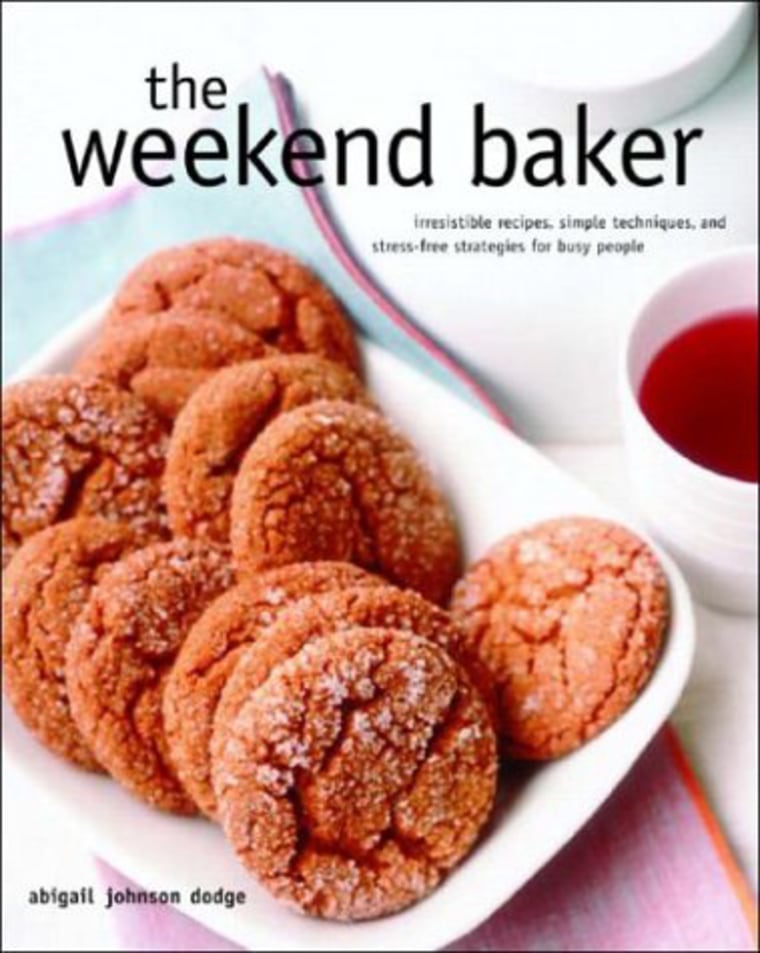
The book's premise is that you control the recipe, it doesn't control you. Each recipe leads off with a list of "do aheads," steps that you can take to help the recipe fit into your schedule.
The recipe for buttery pull-apart dinner rolls, for example, suggests two spots at which a baker can stop the recipe, chuck it into the fridge, and restart 12-24 hours later. Unfortunately, while the dough rose beautifully before it went into the fridge, afterwards it never really recovered, and our Thanksgiving day rolls were heavy and thick. I wondered if I should have let the dough recover outside the fridge longer, but the recipe insisted that the time it took to heat the oven was sufficient. I also tried the stop-start method with a recipe for soft white sandwich bread, and while I still thought the rise was a bit too slowed, the bread didn't suffer from the rolls' heaviness.
But the recipes were overall simple and tasty. The ginger crackles shown on the book's cover were snappy and delightful, as well as easy. And the chocolate-dipped macademia brittle was one of the easier brittles I've made. I thought the so-called supermoist banana-nut muffins weren't really that "supermoist," but they vanished from my kitchen counter quickly.
The book has some photos, but could have used more. I brought the velvety pumpkin tart with gingersnap crust to a Thanksgiving dinner, but it seemed awfully flat to me, and without a photo, I wasn't sure if it should have been fluffier or not. (Tip: Thanksgiving diners will eat just about anything if it's topped with fresh whipped cream.)
I appreciate the book's premise, but it was disappointing that the recipes I did try to stop-and-start were among the least successful. —G.F.C.
Gael Fashingbauer Cooper is MSNBC.com's Books Editor and a former food and restaurant editor. Jon Bonné covers the food and wine industry for MSNBC.com